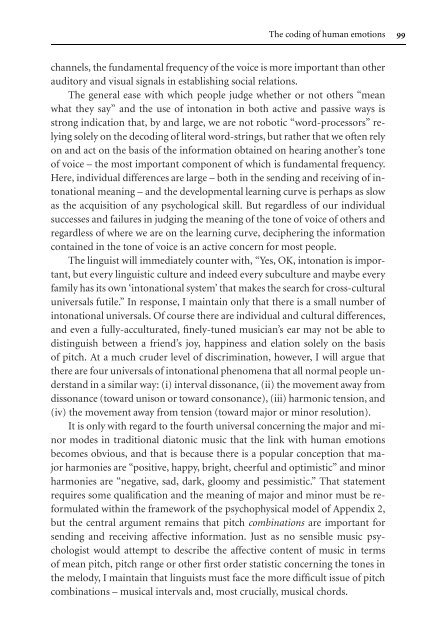Tone of Voice and Mind : The Connections between Intonation ...
Tone of Voice and Mind : The Connections between Intonation ...
Tone of Voice and Mind : The Connections between Intonation ...
Create successful ePaper yourself
Turn your PDF publications into a flip-book with our unique Google optimized e-Paper software.
<strong>The</strong> coding <strong>of</strong> human emotions 99<br />
channels, the fundamental frequency <strong>of</strong> the voice is more important than other<br />
auditory <strong>and</strong> visual signals in establishing social relations.<br />
<strong>The</strong> general ease with which people judge whether or not others “mean<br />
what they say” <strong>and</strong> the use <strong>of</strong> intonation in both active <strong>and</strong> passive ways is<br />
strong indication that, by <strong>and</strong> large, we are not robotic “word-processors” relying<br />
solely on the decoding <strong>of</strong> literal word-strings, but rather that we <strong>of</strong>ten rely<br />
on <strong>and</strong> act on the basis <strong>of</strong> the information obtained on hearing another’s tone<br />
<strong>of</strong> voice – the most important component <strong>of</strong> which is fundamental frequency.<br />
Here, individual differences are large – both in the sending <strong>and</strong> receiving <strong>of</strong> intonational<br />
meaning – <strong>and</strong> the developmental learning curve is perhaps as slow<br />
as the acquisition <strong>of</strong> any psychological skill. But regardless <strong>of</strong> our individual<br />
successes <strong>and</strong> failures in judging the meaning <strong>of</strong> the tone <strong>of</strong> voice <strong>of</strong> others <strong>and</strong><br />
regardless <strong>of</strong> where we are on the learning curve, deciphering the information<br />
contained in the tone <strong>of</strong> voice is an active concern for most people.<br />
<strong>The</strong> linguist will immediately counter with, “Yes, OK, intonation is important,<br />
but every linguistic culture <strong>and</strong> indeed every subculture <strong>and</strong> maybe every<br />
family has its own ‘intonational system’ that makes the search for cross-cultural<br />
universals futile.” In response, I maintain only that there is a small number <strong>of</strong><br />
intonational universals. Of course there are individual <strong>and</strong> cultural differences,<br />
<strong>and</strong> even a fully-acculturated, finely-tuned musician’s ear may not be able to<br />
distinguish <strong>between</strong> a friend’s joy, happiness <strong>and</strong> elation solely on the basis<br />
<strong>of</strong> pitch. At a much cruder level <strong>of</strong> discrimination, however, I will argue that<br />
there are four universals <strong>of</strong> intonational phenomena that all normal people underst<strong>and</strong><br />
in a similar way: (i) interval dissonance, (ii) the movement away from<br />
dissonance (toward unison or toward consonance), (iii) harmonic tension, <strong>and</strong><br />
(iv) the movement away from tension (toward major or minor resolution).<br />
It is only with regard to the fourth universal concerning the major <strong>and</strong> minor<br />
modes in traditional diatonic music that the link with human emotions<br />
becomes obvious, <strong>and</strong> that is because there is a popular conception that major<br />
harmonies are “positive, happy, bright, cheerful <strong>and</strong> optimistic” <strong>and</strong> minor<br />
harmonies are “negative, sad, dark, gloomy <strong>and</strong> pessimistic.” That statement<br />
requires some qualification <strong>and</strong> the meaning <strong>of</strong> major <strong>and</strong> minor must be reformulated<br />
within the framework <strong>of</strong> the psychophysical model <strong>of</strong> Appendix 2,<br />
but the central argument remains that pitch combinations are important for<br />
sending <strong>and</strong> receiving affective information. Just as no sensible music psychologist<br />
would attempt to describe the affective content <strong>of</strong> music in terms<br />
<strong>of</strong> mean pitch, pitch range or other first order statistic concerning the tones in<br />
the melody, I maintain that linguists must face the more difficult issue <strong>of</strong> pitch<br />
combinations – musical intervals <strong>and</strong>, most crucially, musical chords.


